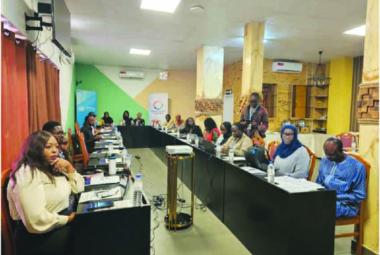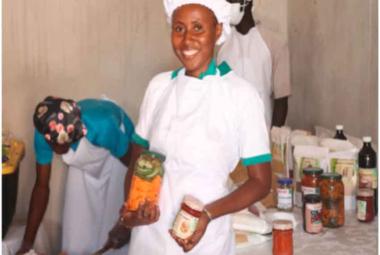By Awa Sowe
In the early 20th century, polio was one of the most feared diseases in industrialized countries, paralysing hundreds of thousands of children every year. Soon after the introduction of effective vaccines in the 1950s and 1960s however, polio was brought under control and practically eliminated as a public health problem in these countries. It took somewhat longer for polio to be recognized as a major problem in developing countries. Lameness surveys during the 1970s revealed that the disease was also prevalent in developing countries. As a result, during the 1970s routine immunization was introduced worldwide as part of national immunization programmes, helping to control the disease in many developing countries.
Rotary International launched a global effort to immunize the world’s children against polio in 1985 followed by the establishment of the Global Polio Eradication Initiative (GPEI) in 1988. When the GPEI started, polio paralysed more than 1000 children worldwide every day. Since then, more than 2.5 billion children have been immunized against polio thanks to the cooperation of more than 200 countries and 20 million volunteers. Today, wild poliovirus continues to circulate in only two countries, and global incidence of polio cases has decreased by 99%. There has also been success in eradicating certain strains of the virus; of the three types of wild polioviruses (WPVs), the last case of type 2 was reported in 1999 and its eradication was declared in September 2015; the most recent case of type 3 dates to November 2012 and this strain was declared as globally eradicated in October 2019. Poliomyelitis (polio) is a highly infectious viral disease that largely affects children under 5 years of age. The virus is transmitted by person-to-person spread mainly through the faecal-oral route or, less frequently, by a common vehicle (e.g. contaminated water or food) and multiplies in the intestine, from where it can invade the nervous system and cause paralysis.
In 1988, the World Health Assembly adopted a resolution for the worldwide eradication of polio, marking the launch of the Global Polio Eradication Initiative, spearheaded by national governments, WHO, Rotary International, the US Centers for Disease Control and Prevention (CDC), UNICEF, and later joined by the Bill & Melinda Gates Foundation and Gavi, the Vaccine Alliance. In her relentless efforts to support the Ministry of Health, First Lady Fatoumatta Bah-Barrow Officially Launched the National Polio Vaccination Campaign at the Poly Clinic in Banjul. Vaccination teams will reach homes, schools, markets, and community ‘Bantabas’ to ensure that every child in the Gambia aged 0 to 5 years receives their life-saving polio vaccine. Launching the polio vaccination campaign exercise, the First Lady Her Excellency Fatoumatta Bah-Barrow underlined the danger of polio saying it is a disease that leads to disability and sometimes death.
“Prevention does not cost anything, but curing costs a lot of money, I call on mothers to be taking their children for antenatal care for at least five complete years to prevent their children preventable illness,” She further encouraged parents to get their eligible children vaccinated against polio disease. She emphasized the importance of immunization, noting that this would save lives and keep The Gambia polio-free. The Honourable Minister for Health, Dr. Momodou Lamin Samateh, thanked the First Lady for her all-time and support to the Ministry of Health, staff of his ministry and the hospital for their hard work and dedication to the health of children.
He commended the government of the Gambia for renovating and uplifting the hospital to a high standard for improve health service delivery. The Minister further recognized the efforts of the First Lady to the health sector saying whatever she brings to the country, “the health sector gets a chunk of it.” Dr Samateh acknowledge He dilated on some of the developmental projects undertaken in the health sector which include renovations, expansion of some health facilities, human capacity building etc The WHO Regional Director for Africa Dr Matshidiso Moeti said that the region has reached significant milestones, including the notable success of Madagascar, which has now gone a full year without detecting circulating variant poliovirus type 1 (cVDPV1). In Southern Africa, we marked the closure of the imported wild poliovirus type 1 (WPV1) outbreak that was declared in 2022.
The swift and coordinated efforts of Malawi, Mozambique, and neighbouring countries Tanzania, Zambia, and Zimbabwe also inspire optimism. These achievements highlight the strength of joint action, the resilience of our communities, and the unwavering dedication of frontline health workers. “Data equally bear out these results. When comparing them from 2023 and 2024 (as of 31 August for each year), cVDPV1 detections have decreased by 96%, while cVDPV2 detections have dropped by 65% in the African Region.” She noted She added that, Strong political commitment is crucial to the fight against polio. Acknowledging the urgent need for renewed collaboration, especially along borders, government leaders, WHO, UNICEF, and other partners joined forces in July and August 2024 to develop a coordination plan aimed at eradicating variant poliovirus in the above countries. As a result, nearly 70 million children in high-risk areas in those countries have been vaccinated since the beginning of the year. She went on to explained that, Vigilance is also critical, as there is a need to enhance surveillance, especially in underserved areas, and accelerate our response to any new detections. Equally important is the need to scale up high-quality vaccination campaigns.
“The latest Independent Monitoring Board (IMB) of the Global Polio Eradication Initiative (GPEI) report also underscores the need for enhanced community engagement. In many regions, especially those affected by insecurity or social mistrust, it is community health workers who make the difference between success and failure. We must continue to support these local heroes, ensuring they have the resources and training needed to reach every child with life-saving vaccines.” She highlighted Furthermore, the rapid advancement of polio diagnostics and sequencing technologies is another significant step forward in our eradication efforts and beyond. She went on to explained that the ongoing trainings across Africa, especially in South Africa, Ghana, Uganda, Nigeria and Kenya, laboratory capacity has grown. This allows for faster identification and response to outbreaks.
“Our goals are clear. We must remain vigilant through robust surveillance systems, respond rapidly with high quality vaccination campaigns, improve routine immunization coverage, and ensure that the polio program’s infrastructure continues to benefit other public health priorities. Progress is real, but setbacks can occur when we lose vigilance. Our success is not just Africa’s—it is the world’s. With sustained momentum, strong leadership, and global solidarity, a polio-free future is within our reach. Together, we can attain a polio-free world”. She concluded
A polio-free world is within reach, but only if we continue to vaccinate. Support efforts to immunize every child in The Gambia. The oral polio vaccine is safe and effective in preventing the disease. Let us ensure every child receives this vaccine; for vaccination is our strongest weapon against this disease. The campaign is supported by the Government of The Gambia, the UN System, the World Health Organization, and Partners.







